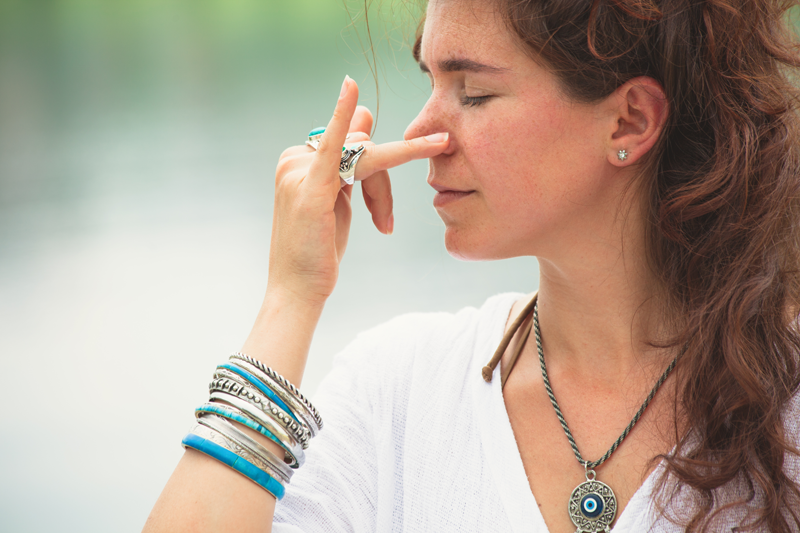During an Ashtanga class, the main sound you’ll hear is the practitioners’ breathing. This is because they are using a technique called Ujjayi breathing, which is also known as ‘breathing with sound’. The foundation of Ashtanga yoga is built upon this technique, so it’s important to practice it correctly to get the most from your practice. Some people assume that Ashtanga is an intense physical style, however, that’s not always the case. The main focus of Ashtanga is breath. Once you’ve nailed Ujjayi breathing, you can add in more complex postures if you so wish. In this article, we explore the perfect way to breathe in Ashtanga yoga. If you want to learn the technique, put on your yoga pants and follow along.
What is Ujjayi Breathing?
Ujjayi Breathing is practised in Ashtanga Vinyasa classes to create heat and stability within the body. This breathing exercise is also referred to as Victorious Breath or Ocean Breath. The pranayama can help yogis to take their time with each posture, reminding them that proper breathing is more important than an idealised shape. It can be helpful to practice this pranayama after a sequence of strenuous poses to lower the heart rate; with this in mind, Ujjayi breathing is also beneficial in Vinyasa flow classes. Like any mindful breathing, Ujjayi can be used to increase the awareness of our breath. Additionally, practising the technique can teach us to use our full lung capacity. Breathing fully, rather than shallowly, will allow a better flow of oxygen to the brain.
How to Practice
Practice Ujjayi breathing by inhaling and exhaling through your nose. Drag the breath along the back of your throat so that it creates a gentle hissing sound and feels like sipping a cool drink through a straw. Try to make each inhale last as long as the exhale and take each breath a little deeper than the last until your breathing is long and smooth.
The Perfect Way to Practice
Below, we explore some of the key principles for Ujjayi breathing. This will help you to breathe perfectly and get the most from your practice. If you’re a beginner, you may choose to focus on the first few principles and build the others over time.
Engage the Bandhas
For perfect Ujjayi breathing, engage the Mula and Uddiyana Bandhas. Doing will make sure the prana you are generating does not leave the body as you exhale; instead, the energy will be locked in and drawn upwards.
When the bandhas are engaged, your lower stomach won’t move in and out. Instead, it will be zipped in and remain still. This pushes the air up into the throat and allows you to use your lungs to their full capacity. This is a more effective way of breathing and also protects your lower back by switching the intrinsic core muscles on.
While the lower stomach should be ‘zipped in’, the rest of it should remain relaxed as you inhale to avoid restricting the movement of the diaphragm. It’s only the lowest part of your belly that should stay firm throughout. At first, it may be hard to isolate the two but don’t panic, this will come with regular practice.
Breathe Through the Nose
Breathing through the nose is preferred in Ujjayi breathing for various reasons. Firstly, it allows you to exhale slower by creating a smaller cross-sectional area for the air to travel through. Secondly, the nose benefits from a 4-stage filtration system to cleanse the air before it goes into the lungs. With this in mind, breathing through the nose takes in less pollution than breathing through the mouth. Finally, ancient yogis believe that nose breathing opens the central energy channel, or the Sushumna Nadi. This enables the prana to move freely through the body.
Breathe in 3 Dimensions
As you breathe in, imagine the lungs expanding in three dimensions. The air should first fill the thorax in the front, then expand the sides and the back of the ribs. Using this three-dimensional technique, rather than just expanding the front of the chest, will ensure you’re using the full capacity of your lungs.
Breathe with Sound
For best results, try to breathe with sound in Ujjayi breathing. By softly contracting the vocal cords, you can control the speed of your breath and start to slow it down. Instead of making a loud sound, the breath should make a gentle hissing sound. Focussing on this sound can your attention inward and activate the parasympathetic nervous system. With practice, this helps us to tune into the subtle body.
Equalise the Inhale and Exhale
Often, the inhale and exhale are different lengths. This can be linked to an excess of tamas or rajas in the mind. For perfect breath, equalise the length of your inhale and exhale to create a calm and balanced mind.
Free Your Breath
During a yoga class, the teacher will count the breath to give you a guideline. However, you don’t have to stick to this. Don’t hold your breath just to stay in time with the class; instead, let your breath flow freely. For best results, take long, slow breaths without holding your breath in between.
Allow Breath to Lead Movement
Throughout the Ashtanga class, let your breath lead the movement, not the other way around. Instead of raising your arms and then breathing in, initiate the inhalation first and let your breath carry your arms into position. While this may seem unnecessary, it can make a big difference to the energy of your practice. When you lead with your breath, the movement will become effortless.
In Summary
So, there you have it – the perfect way to breathe in Ashtanga Yoga. For best results, practise Ashtanga in a breathable yoga top to allow the body to oxygenate. With regular practice, the tips above will help you to achieve perfect breath in Ashtanga.

